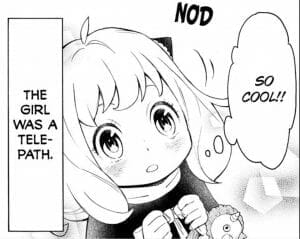At the start of Tatsuya Endo’s Spy x Family, a family – man, woman, and a small child – sit around a table. They exchange loving smiles, surrounded by the fluffy pink glow of loving domesticity. “Everyone has a secret self they don’t show to other people,” the text around them reads. “Not to friends, not to lovers, not even to family. They hide who they are and what they want behind painted smiles. And thus the world maintains its thin veneer of peace.” This, in a 10-word nutshell, sums up Endo’s deployment of the traditional family unit – part slice-of-life sit-com, part socio-political satire; a unit that, if compromised, could bring about the end of the world as we know it.
Spy x Family began serialization on the Shonen Jump+ app in March 2019. Since its debut, the series has gone on to become a major commercial and critical success. “I’m a big fan of movies and anime where the character are hiding who they really are,” reads Endo’s afterword (translated by Casey Loe) in the first volume. “I love the tension of ‘Will they be discovered?’ and the anguish of them wanting to reveal their secrets and not being able to.” He adds: “There isn’t any of that in this manga, but I hope you enjoy it anyway.” So far, Endo has been true to his word. The members of the Forger family have little concern for peeking into each other’s hidden lives. Indeed, they’re far too concerned with outsiders doing that instead.
As the name makes no secret of, the Forgers are a fake family, formed by Loid Forger – the cover name of the spy known only as “Twilight.” As part of “Operation Strix,” Loid is instructed to find himself a wife and child in order to cozy-up to a politician who poses a threat to national unity. The statesman is a reclusive man, to the point that one of the few confirmed places he shows his face is at an elite boarding school. Naturally, Loid’s best bet is to enroll a child of his own to the school, curry favor with his target’s son, and worm his way into the academy’s upper circle. Imperative to his success is presenting, to the prying eyes of the enemy, a family that could never be suspected of being anything but normal and, most importantly, real.
The problem is Loid has just one week to assemble this perfectly real and normal family. A few obvious complications arise, particularly where having a school-aged child is concerned. After all, it’s not possible to pull that off biologically.

Enter Anya, a six-year-old girl desperate to be whisked away from the squalid orphanage she’s stuck in, and Yor Briar, an introverted office worker desperate to stop being judged for not having bagged herself a good husband yet. Like Loid, Anya and Yor don’t fit into normal society, though in Loid’s case, his outsider status was made through choice rather than circumstance. Anya and Yor were “othered” by forces beyond their control, which is so often the case for girls and women, though they’re not without their own secret weapons. Anya, a product of covert scientific experimentation, is a telepath while Yor is a top-class assassin known as Thorn Princess. While they’re blissfully unaware of Loid’s real vocation and mission, Loid also is none the wiser about his new wife and daughter’s abnormal skills.
It’s through this lens that the peace-keeping stakes of the fake family’s existence are established. Should the Forger family be rumbled, Loid’s mission would also be compromised. With this concept in mind, we could reasonably argue that the failure of the idealized nuclear family is directly linked to the breakdown of civilized, Western society. Though it may not sound like it, it’s a premise that Endo uses masterfully for situational comedy, but also, more subtly, subversion.
The published definition of the “nuclear family” is “a pair of adults and their socially recognized children.” It’s a term that’s actually far older than one might think – dating back to the 1920s. Since the dawning of nuclear power, though, we’ve come to associate it inextricably with the era that gave rise to the Cold War, the assassination of President John F. Kennedy, and the setting for Mad Men. This era also inspired the backdrop for Spy x Family’s mid-century, modern aesthetic and geo-political landscape. The series takes place in a fictionalized version of a divided, post-World War II Berlin where an uneasy truce hangs between the Eastern Ostania and the Western Westalis (of whom Loid is allied with).
The setting greatly amplifies the connection between the fake family’s importance to its story, not to mention the real-world importance placed on the nuclear family. As Merriam-Webster puts it, “the nucleus has origins meaning ‘kernel’ or more simply ‘something essential.’” The curtain-twitching paranoia of an enemy that could easily embed themselves on the wrong side of a wall gives way to a sense of paranoia over not being seen as a “proper family” for Loid, Yor, and Anya. Their interactions, therefore, are the performance of domesticity according to established social standards, rather than the ‘real,’ lived experience of it. Though, of course, the performance inevitably blurs the line between the two before long.
Across the Atlantic, there’s a parallel that could be drawn in this fictional world to America’s Red Scare. Originating in the 1950s, America’s fear of Communism from the East resulted in the nuclear family being used as an anti-invasion tool. Domestic containment, as it was branded by George F. Kennan, a diplomat whose writings had a big influence on President Truman’s foreign policies, prized the preservation of American values through the suburbanized, traditional family unit. Communism was viewed as a direct threat to American freedom, and the nuclear family vulnerable to its “evils.”

In Spy x Family’s caricature of this environment, suspicious neighbors are a daily threat to Loid’s mission, and appearing as the perfect husband, wife, father, mother, and daughter in public is an unending, exhausting job. As Twilight, he was able to be a mere fly on the wall. His disguises enabled him to be a tourist in a world of social hierarchies, marriage, and dinner parties, but never a permanent resident. “Never forget that everyone else’s day-to-day lives are possible because of your blood and sweat,” his handlers remind him at the commencement of Operation Strix. Loid, a child of war, is unwavering in his loyalty to this directive. In place of an identity of his own, his national identity and pride are all that matters. Ironically, for its anti-Communist inspiration, Loid emphasizes conformity over individuality. “A father is just another role to play,” he explains, “I will play it to perfection.”
The speed at which Loid manufactures the Forger family, and their continued success in appearing “perfect,” completely undermines the nuclear family’s sense of “authenticity.” In this light, the enforcement of a set family structure, at the expense of all others, is not only illusionary, it can also breed demonization. In addition to its usage as an anti-Communist tactic, domestic containment doubled as an effort to create secure home environments, which were reliant on traditional gender roles to stabilize a post-war society, one that women were less than enthused about. Having gained unprecedented autonomy in the workplace during World War II, women in the U.S (and other Allied nations) were expected to return to the home and become its domestic backbone, as well as the sexual servants of their husbands and primary caregivers to children.

In reality, over 40 percent of the North American workforce by the mid-’60s were married women with school-aged children, but the propaganda machine was relentless in its moral judgment of any woman who pursued such deviation. In Spy x Family, Yor’s position as a single working woman is similarly preyed upon, to the point that when she arrives at a party alone after insisting she’d bring a boyfriend with her, she’s suspected of being a “spy sent here to lower the country’s birth rate.” Physically ostracized for her “lying,” Yor looks on at the party-goers, laughing and making small talk with each other as happy couples, and realizes that “this is what ‘ordinary’ looks like.” (Little do they know that, as Thorn Princess, Yor could murder them all in seconds with nary a moment’s thought.)
For these reasons, Loid and Yor are a perfect match to form their own unconventionally conventional family unit. Loid, uninterested in a normal life, cares little for Yor’s shortcomings in the home (her cooking is her other deadly skill), or that she’s a career woman. Yor, meanwhile, is simply relieved that having a husband and child, even if it’s a sham, will shelter her from the pressure to be a real wife and mother. Even Anya, with her ability to read minds, isn’t unaware of the artificiality she’s been adopted into. In fact, despite being the “clueless” character of the trio, she’s always the most in-the-know because of it. Still, Anya also doesn’t care that her family is a fake one, because a fake family is still a family. The three of them might only be together for the sake of convenience, but their individual needs do form a bond between them. Loid is pleased – proud, even – when Yor and Anya succeed, and vice versa. To uphold the lie, they are fiercely protective of one another.

In this regard, the Forger family might be a fake nuclear family, but they are a real chosen family – its modern successor. Chosen families, driven by the LGBTQIA+ community, expand the definition of “family” to include support networks of those we love and trust. They’re usually formed when those needs aren’t met by one’s biological kin. Though Loid, Yor, and Anya aren’t completely honest with each other about who they really are, the home they’ve created is one of genuine refuge and shielding for a group of societal misfits. But Spy x Family is stuck in the middle of the retrogressive 20th century, and they’re woefully ahead of their time to be accepted by the mainstream.
Writing for The Atlantic, David Brooks criticized the nuclear family for being too “brittle,” blaming its dismantling in the 1970s on predominantly cultural strains. “Society became more individualistic and more self-oriented. People put greater value on privacy and autonomy. A rising feminist movement helped endow women with greater freedom to live and work as they chose.”
And yet, the allure of the nuclear family remains pervasive for some governments even today. In 2015, the U.K’s Conservative-Liberal Democrat coalition introduced a tax break for newly registered married couples. Then-Prime Minister David Cameron said, “This policy is about far more than pounds and pence. It’s about valuing commitment. Families are the bedrock of our society. It is families who raise our children, look after our old, and keep our country going. And this tax change is about saying as a society, we recognize that.” Distracted, perhaps, by his self-given duty as a “defender” of the institution of marriage, Cameron failed to take into account that the number of unmarried people in the country was steadily increasing, and his Marriage Allowance crashed and burned.
Historically, the traditional family unit has repeatedly been perversely corrupted, not by shadowy foreign powers, but by domestic governments consumed by xenophobia and fear of the unknown. Women, queer people, people of color, and others who make up society’s most vulnerable are always the ones who suffer because of it, while the pressure to be the “breadwinner” also has a detrimental effect on the mental health of men. By hastily assembling this unit for the wrong reasons, Spy x Family casually dismantles the nuclear family, exposing it as the carefully constructed myth that it’s always been while lampooning its inflated importance. Some proponents of the institution of marriage and family, like Cameron, would have us believe that society will crumble should this institution fail. Spy x Family takes this idea and plays it as it should be played: for laughs.












